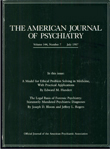Low glucose metabolism during brain stimulation in older Down's syndrome subjects at risk for Alzheimer's disease prior to dementia
Abstract
OBJECTIVE: Down's syndrome is characterized by the genetically programmed accumulation of substantial Alzheimer's disease neuropathology after age 40 and the development of early dementia years later, providing a unique human model to investigate the preclinical phases of Alzheimer's disease. Older nondemented adults with Down's syndrome show normal rates of regional cerebral glucose metabolism at rest before the onset of dementia, indicating that their neurons maintain function at rest. The authors hypothesized that an audiovisual stimulation paradigm, acting as a stress test, would reveal abnormalities in cerebral glucose metabolism before dementia in the neocortical parietal and temporal areas most vulnerable to Alzheimer's disease. METHOD: Regional cerebral glucose metabolism was assessed by means of positron emission tomography (PET) with [18F]fluorodeoxyglucose in eight younger (mean age = 35 years, SD = 2) and eight older (mean age = 50, SD = 7) healthy, nondemented adults with trisomy 21 Down's syndrome. PET scans were performed at rest and during audiovisual stimulation in the same scanning session. Levels of general intellectual functioning and compliance were similar in the two groups. RESULTS: At rest the two groups showed no difference in glucose metabolism in any cerebral region. In contrast, during audiovisual stimulation the older subjects with Down's syndrome had significantly lower glucose metabolic rates in the parietal and temporal cortical areas. CONCLUSIONS: Abnormalities in cerebral metabolism during stimulation appeared in the first cortical regions typically affected in Alzheimer's disease. These results indicate that a stress test paradigm can detect metabolic abnormalities in the preclinical stages of Alzheimer's disease despite normal cerebral metabolism at rest.



